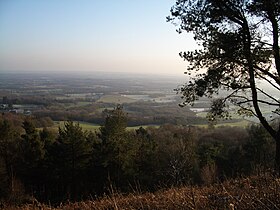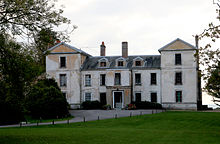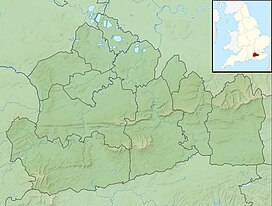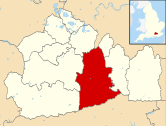Leith Hill
| Leith Hill | |
|---|---|
 |
|
| Highest point | |
| Elevation | 294 m (965 ft) |
| Prominence | 249 m (817 ft) |
| Listing | Marilyn,[1] Hardy, County Top |
| Coordinates | 51°10′33″N 0°22′11″W / 51.17583°N 0.36972°WCoordinates: 51°10′33″N 0°22′11″W / 51.17583°N 0.36972°W |
| Geography | |
|
Leith Hill in Surrey
|
|
| Location | Surrey, England |
| Parent range | Greensand Ridge |
| OS grid | TQ139431 |
| Topo map | OS Landranger 187 |
Leith Hill is a wooded hill 7 km to the south west of Dorking, Surrey, England. It reaches 294 metres (965 ft) above sea level,[2] the highest point on the Greensand Ridge,[3] and is the second highest point in south-east England, after Walbury Hill near Hungerford, West Berkshire, 297 metres (974 ft) high.[1]
It was possibly on the summit of Leith Hill in 851, that Æthelwulf of Wessex, father of Alfred the Great, defeated the Danes who were heading for Winchester, having sacked Canterbury and London.[4]
The nearest railway station is Holmwood Station, 2 miles (3.2 km) to the east. This station is served by Southern trains on the Sutton & Mole Valley Line route.
Contents
Battle Of Leith Hill[edit]
The hill's first notable role in history was as a battlefield in the ninth century struggle between Saxons and Danes. In 851AD the Danes planned a full scale invasion, after raiding the country regularly for many years. The Danes invaded up the Thames and burnt Canterbury and then London. The next target was Winchester, but on their march towards Winchester they met the army of Ethelwulf, father of Alfred the Great. Ethelwulf, it seems, took up a position on the slopes of Leith Hill - an ancient mass grave found in 1882 seems to point to this area as the sight of battle (Stories of the Surrey Hills published by the Surrey Society). Ethelwulf was able to use position on high ground to win the huge battle that followed. This battle ended the Danes immediate prospects of conquering the whole of Britain.[4]
Leith Hill Tower[edit]
On the summit of Leith Hill is an 18th-century Gothic tower. In 1765-6 Richard Hull of nearby Leith Hill Place built "Prospect House", later to become known as Leith Hill Tower, with the intention of raising the hill above 1,000 ft (305 m) above sea level. The tower is 19.5 metres (64 ft) high and consisted of two rooms "neatly furnished", with a Latin inscription above the door announcing that it had been built not only for his own pleasure, but also for the enjoyment of others. Hull provided visitors with prospect glasses, similar to a small telescope, through which to survey the extensive views towards London and the English Channel, each some 25 miles (40 km) away.
When he died in 1772, at his request he was buried under the tower. Following his death, the building was stripped of its contents, doors and windows, and fell into ruin. As a result, the tower was filled with rubble and concrete, and the entrance bricked up.
In 1864, Mr Evelyn of nearby Wotton House decided to reopen it, but the concrete made this difficult, and so the additional turreted side-tower was added to allow access to the top of the tower.
At the top of the tower there is a viewpoint indicator to commemorate Walker Miles, whose work in the early days of the Rambler's movement contributed to the formation of The Ramblers of Great Britain. It has been claimed that on a clear day, 13 counties can be seen from the top of Leith Hill Tower.[5]
The tower was fully restored by the National Trust in 1984. This restoration included the removal of rubble and concrete, fitting safety features such as a handrail in the narrow staircase, and converting the lower portion of the tower into a servery. Leith Hill Tower is open to the public every day from 10:00 am until 3:00 pm weekdays and 9:00 am to 5:00 pm on weekends, every day of the year except Christmas Day, with a comprehensive display explaining the history of the tower. Standing on the top of Leith Hill Tower you are at the highest point in the south-east of England.
Leith Hill Place[edit]

Originally a gabled house dating from about 1600, Leith Hill Place was completely refaced in a Palladian style about 1760 by Richard Hull.[6] It was bought in 1847 by Josiah Wedgwood III and remained in the family until the composer Ralph Vaughan Williams, who had been brought up there and eventually inherited it, gave it to the National Trust in 1944. Subsequently it was leased from the Trust by his cousins Sir Ralph Wedgwood and then Sir John Wedgwood, later becoming a boarding house for a nearby sixth form college, Hurtwood House. The property is claimed to be haunted, with several School Masters of the day reporting strange goings-on, noises and even apparitions. The house was opened to the public by the National Trust in 2013.[7]
Josiah Wedgwood's widow, born Caroline Darwin, created a rhododendron wood there, now open to the public.[8]
Search For Oil[edit]
Europa Oil and Gas is currently (Nov 2016) undertaking an attempt to drill for oil under the Leith Hill area, using a horizontal drill rig passing under the nearby Coldharbour Village. This involves the cutting down and clearing of approximately 1 hectare of natural forest woodland and building a tall drilling rig that will be visible for many miles around. Two protest groups are currently making an attempt to stop this, one a legal orientated protest group known as Leith Hill Action Group[9] and a non-violent land occupation group known as the Leith Hill Protection Camp.[10]
Geodesy[edit]
Leith Hill Tower was the origin (meridian) of the 6 inch and 1:2500 Ordnance Survey maps of Surrey.[11]
References[edit]
- ^ a b Dawson, Alan (1992). "The Marilyns by Height". The Relative Hills of Britain. Milnthorpe, Cumbria, England: Cicerone Press. ISBN 1-85284-068-4. Dawson draws his information from various editions of Ordnance Survey maps, but he does not specify which.
- ^ Bench marks km square TQ1343: The exact height of the benchmark on the tower, surveyed in 1972, is 293.8730 metres AMSL. The cut mark is O.5 m off the ground, hence a height of 293.4 m. On the 1:50000 ordnance map this is rounded to 294 m. Dorking, Reigate and Crawley area (Map) (10GSGS ed.). 1:50000. Landranger 187. Ordnance Survey. 1991. ISBN 0-319-22187-3.
- ^ Gallois RW and Edmunds FH (1965) British Regional Geology: The Wealden District published by the National Environment Research Council: Institute of Geological Sciences
- ^ a b "Leith Hill". www.infobritain.co.uk. Retrieved 2016-12-06.
- ^ surreyhills.org
- ^ Ian Nairn and Nikolaus Pevsner, Buildings of England - Surrey, Penguin, 1962
- ^ Leith Hill Place, accessed 18 October 2015
- ^ gardenvisit.com
- ^ "Leith Hill Action Group | Meet the LHAG Team". www.surreycommunity.info. Retrieved 2016-11-04.
- ^ "Leith Hill Protection Camp". www.facebook.com. Retrieved 2016-11-04.
- ^ https://www.charlesclosesociety.org/files/153Meridians.pdf
External links[edit]
| Wikimedia Commons has media related to Leith Hill. |
- Leith Hill information at the National Trust
- Computer generated summit panoramas North South index


